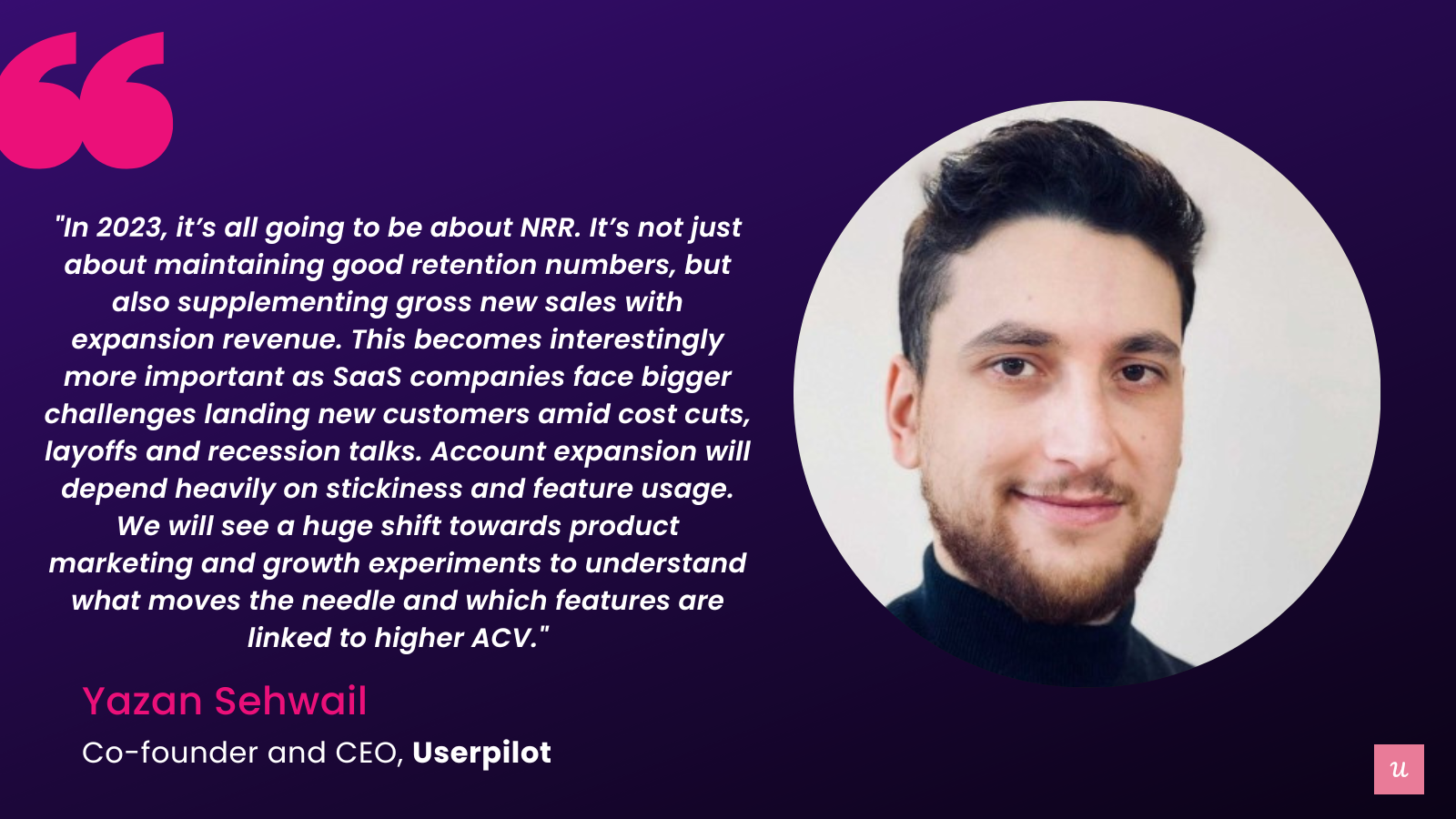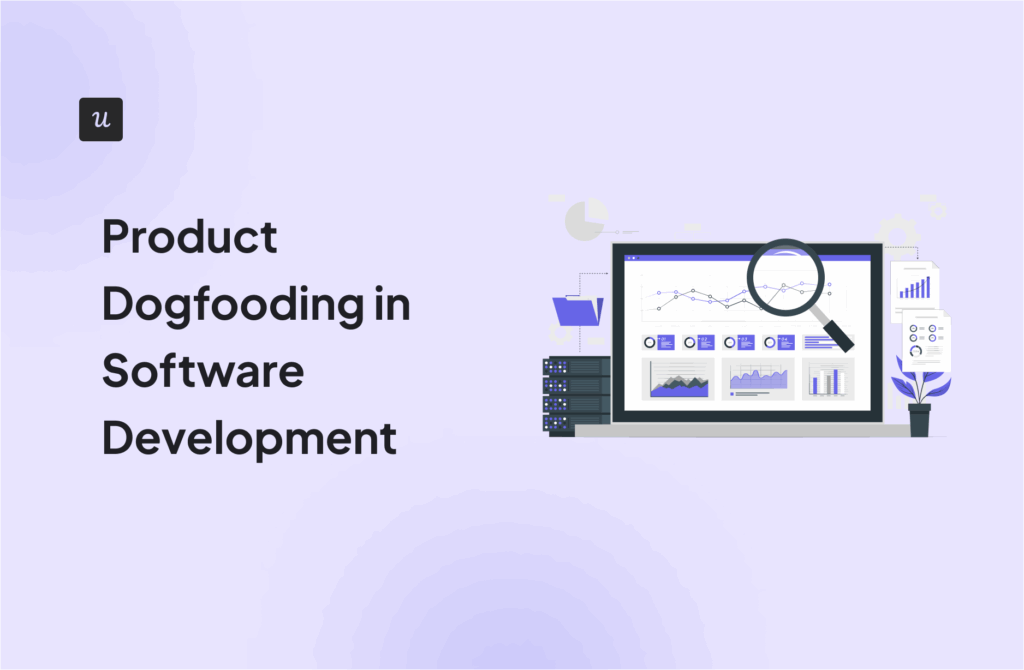
Product Trends 2023 – AI, AI &…driving more value. Top product experts share their opinions.
Which Product Trends will take 2023 by storm? After the overnight success of Chat OpenAI, it’s no wonder predictions related to using AI and machine learning to increase our understanding of user behavior, greater automation of low-level tasks, and GPT-4 dominate Product Managers’ and Marketers’ projections for the upcoming year. But apart from new technologies, we saw also another big emerging trend: a greater emphasis on…simply creating more value for your users through continuous discovery and being more attuned to user feedback and needs.
As every year, we’ve asked top product experts to share their opinion on the upcoming industry trends. Let’s see how Product Trends will shape up for 2023, how they compare to the 2022 and 2021 predictions, and what Product Resolutions our top-thought leaders made for the upcoming year!
Try Userpilot Now
See Why 1,000+ Teams Choose Userpilot

Product Trend 2023 no 1: AI, Machine Learning, and more Automation – the remedy to layoffs?
The first trend emerging from this year’s survey of top Product Management and Marketing practitioners is clear: AI is going to be implemented increasingly in product offerings and employed to compensate for the shortfall in staff caused by layoffs.
While this may sound dystopian to some, Vazgen Babayan, Group Product Manager at Adobe, is optimistic AI will bring about positive changes and more disruptive innovations. The new products will also emerge as a result of the greater availability of talent in startups:

“I think a lot of people in product saw the overnight success of Chat GPT and will try to jump on that bandwagon. This will also combine with the layoffs happening all over the world and the unprecedented ease of launching new products to market with little to no capital. The result – we will see emergence of some really cool, disruptive products, sometimes even entirely new genres of software and hardware. The same layoffs will also make top talent available to the startups today and we will see more motion from those to uproot established leaders in seemingly impenetrable markets.
I also think that we will see a faster growth in green technology space, as the changed macroeconomic conditions push countries away from reliance on external sources of energy.”
Sanket Totewar, Principal Product Owner at SAP, agreed that the massive layoffs in tech companies we saw in 2022 will require Product Managers to implement more automation:

Parth Shrivastava, the Lead Product Marketer at Bureau, Inc, also pointed out that AI will help product managers automate more of the low-level tasks and allow them to focus more on creative and strategic work:
“In terms of the biggest trends we see this year is the injection of AI (with the imminent advent of GPT4) in product and product marketing. For example, PMs and PMMs can automate a chunk of their manual tasks such as PRD writing, basic content creation, image generation, video editing, real-time sales assistance, etc. So that PM and PMMs can concentrate on more strategic initiatives.”

Speaking of automation – if you’re feeling the pinch of staff shortage in your Customer Success department, why not automate your new user onboarding? Growth Mentor reduced their support ticket volume by 83% after implementing Userpilot’s onboarding checklists and Resource Center into their product.
You can also create mobile-first onboarding flows with Userpilot, customizing welcome screens, carousels, and slideouts to deliver personalized messaging.
Book a free consultation to see how Userpilot could help you achieve a similar result!
Implementing AI features into core product offerings
Lenka Brozmanova, CMO at Nicereply, is confident we will see more SaaS products implement AI-features into their core offerings. And for sure – even in 2022, we’ve seen a lot of companies tap into the power of GPT-3 API in order to provide text summaries, translation, and more accurate data analytics for their users.

Awni Shamah, Head of Product at Userpilot, added that the AI features we will see more and more often will be used mostly for behavioral user analytics, allowing more personalization (which is consistent with the personalization product trend predicted in 2022).
“I think 2023 will witness a bigger shift to using AI-driven personalized experiences and user engagement. The shift will be mainly focused on embedding AI & ML features within products to measure what matters and better understand user behavior allowing companies to respond with more personalized, engaging, and highly contextual experiences.”

Product Trend 2023 no 2: Value first – more discovery, fewer features
Amidst the rise of AI tools and their inevitable impact on SaaS products, many senior Product Managers still emphasized the need for going back to the basics: recognizing that all features, AI-driven or not, need to ultimately drive value for the user.
Andrea Saez, Senior Product Marketing Manager at Trint, said that the biggest product trend of 2023 will be “taking more time to understand how we are providing value – and if we truly are.”

“So far PMF has been approached as a point in time in which we get funding, but we never stop to think if PMF is a context in which we provide value, and how we might do that better.”
– adds Andrea.
Emilie Lindström, Product Consultant and Coach at Value Rebels, seems to agree:
“I see a change in mindset coming, where we go towards feature minimalism, reducing the noise to create true value for our customers & users.”

Emilie, who worked as a Senior Product Manager at Outfittery for several years before becoming a product consultant, recognizes that a lot of times, more features can damage the product instead of creating more value. Increasing feature velocity at the expense of doing continuous product discovery to uncover what the users really need can lead to a cluttered product experience full of features nobody needs.
As David Pereira, a Product leader with 15 years of experience mentioned in his post on feature minimalism:
“When focusing on shipping features, teams will likely miss the point of increasing value. Most companies focus on maximizing output, so you better focus on maximizing value.”
Lenka Brozmanova also claims companies in 2023 will have “an even stronger focus on listening to their customers’ needs and implementing their requests into their roadmap.”

Are you also planning to run more in-app surveys to understand your users’ needs better next year? Try Userpilot for free now, build micorsurveys inside your product without coding and collect feature feedback from your users on autopilot:

Product Trend 2023 no 3: More companies embracing the subscription model, greater focus on sustainability
Remember the market’s amusement (and bemusement) when BMW introduced a paid subscription for…seat heating in its new cars this year? In 2022, we saw more and more companies shifting towards the recurring revenue model in a bit to achieve more predictability and stability. No wonder a lot of PMs and PMMs spotted this trend as well.
As Anas Totatthil, Product Marketing Manager at Innoventsoft, mentioned in our survey:

“In B2B, I think we’re bound to see more and more companies adopting subscription-based service models. It might not be easy. And it has its own challenges, like users can easily jump ship since there wouldn’t be year-long contracts. So customer experience would matter more than ever. Also, a slew of companies might become SaaS-based, hoping to drive faster product adoption and push more products to the market easily.”
One of our Product Drive speakers, Nico Trofim-Bancila, a Product Marketing Manager at Spryker, also emphasized the growing popularity of the marketplace model aimed at achieving higher sustainability in the product world as one of the upcoming product trends for 2023:
“Personally, I see large enterprises having sophisticated use cases concentrated around marketplaces. Building on this, there is a positive trend of launching marketplaces that contribute to sustainability by focusing on waste management, circular economy and more. Especially in industries such as Automotive, Manufacturing, Retail, Fashion, Food& Bev Electronics, Agriculture, Chemistry and Construction. Hence in 2023 more and more companies will consider creating features or products that contribute to sustainability and, at the same time, an increasing number of enterprises will pay more attention and include sustainability in their business models and future plans.”

Userpilot’s CEO, Yazan Sehwail, in turn, pointed to the growing importance of Net Revenue Retention in the light of the global downturn and layoffs:
“In 2023, it’s all going to be about NRR. It’s not just about maintaining good retention numbers, but also supplementing gross new sales with expansion revenue. This becomes interestingly more important as SaaS companies face bigger challenges landing new customers amid cost cuts, layoffs and recession talks. The strategy shift to ‘land and expand’ will have a huge impact on how product teams operate. On the one hand, it becomes crucial to offer an ‘easy’ way for customers to get going and experience value, even with plans that offer less functionality. Product experience and ease of use will become the key difference as even giants like Salesforce are now embracing the self serve option to get customers started. On the other hand, account expansion will depend heavily on stickiness and feature usage. We will see a huge shift towards product marketing and growth experiments to understand what moves the needle and which features are linked to higher ACV.”
How do 2023 Product Trends compare to last year’s Product Trends?
In the 2022 edition of Product Trends, we didn’t see so many PMs mention AI and automation of menial tasks as the key trends for the upcoming year. There was more stress on improving feature and product adoption, data-driven product decisions and personalization.
At the end of 2021, our experts predicted that in 2022, product managers will become increasingly reliant on data to make decisions and create personalized product experiences for users. This shift was supposed to be driven by the increasing competition in the SaaS market and the availability of AI tools and code-free product growth tools that allow for predictive user behavior analysis and personalized product adoption experiences.
Product Resolutions 2023
Traditionally, we also asked our experts if they had made any “New Year’s product resolutions” for 2023 – metrics they’d like to improve, new processes they would like to implement etc.
Here are the most interesting Product Resolutions we heard our experts make:

- “Improving user activation and feature adoption of our new website surveys”- Lenka Brozmanova, CMO at Nicereply
- “Have a more cohesive strategy between product and marketing. Product has to have a commercial focus in order for all teams to be successful.” – Andrea Saez, Senior Product Marketing Manager at Trint
- “1) Improving the predictability of delivery – from a product ownership perspective.
2) Reducing “time to insight” – creating a framework to allow product management insights to reach the relevant team without hassle.
3) Reducing “time to action” – migrating engagement from “to be sunset” features to alternative solutions within the product.” – Sanket Totewar, Principal Product Owner at SAP - “Focus on solving one problem at a time and provide a great customer experience.” Anas T, Product Marketing Manager at Innoventsoft
- “Help more teams harness the power of PLG to smash their 2023 growth goals.” – Yaakov Carno, Product Led Growers, Founder
- “My goal for the next year will be to do my best to help my team of PMs to be as successful as they can be. Activation, feature adoption and retention will just be one of the outcomes of that effort.” – Vazgen Babayan, Group Product Manager at Adobe
- “1) Improving the conversion rates on the entire funnel 2) Move from a sales-led to Product-led strategy and 3) Improve customer marketing.” – Parth Shrivastava, the Lead Product Marketer at Bureau, Inc
- “Improving sickness and retention.” – Awni Shamah, Head of Product at Userpilot.
Conclusion – will AI free us all?
This year’s Product Trends survey showed unprecedented unanimity among product people – AI will be increasingly becoming an everyday part of our work in Product Management and Marketing. There’s optimism that AI and ML will help us make better data-driven decisions, and free us from doing boring tasks that could be automated.
Will the projections come true? Let’s wait and see!







